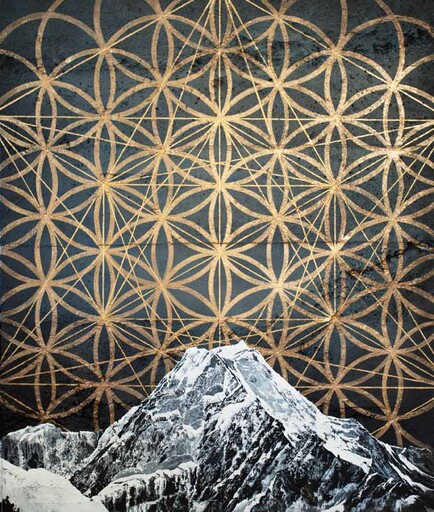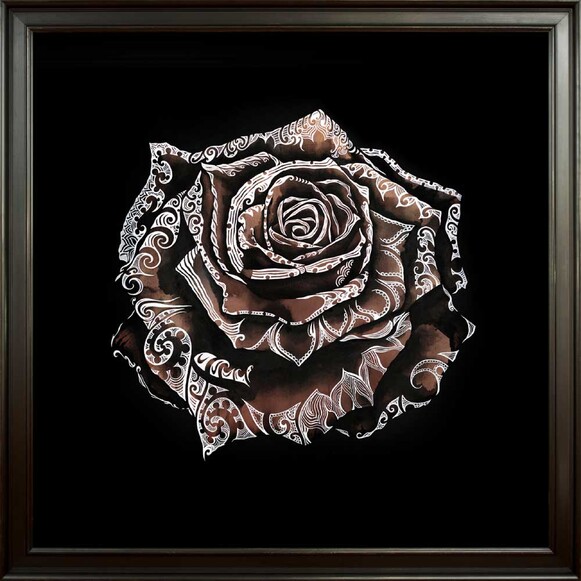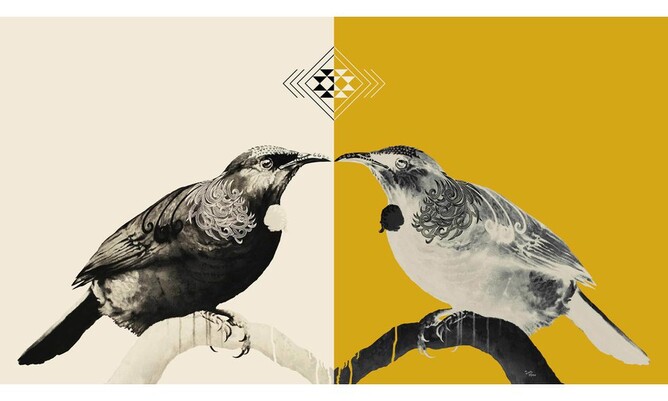Māori mythology has been a continual source of inspiration in Sofia's Māori art and Māori portraits. The myths of creation have been particularly important.
Na Te Kore, Te Pō
Ki te Whai-Ao
Ki te Ao-Mārama
Tihei mauri-ora
From the void, the night
To the glimmer of dawn
To the bright light of day
There is life
- Te Kore
The Māori creation stories help us understand the beginnings and origins of life. We can look at creation in three movements.
It begins with Te Kore, the void of unlimited potential in which nothing exists. From there comes Te Pō, aeons of darkness and night. Finally, from Te Pō emerges Te Ao, the light and the world.
Long before the embrace of sky father Ranginui with earth mother Papatūānuku, before the gods of the natural world emerged, and before life began, there was Te Kore, the void.
The cosmogony of Te Kore, Te Pō and Te Ao has captivated Sofia for decades, providing her with a psychological and spiritual framework for the origins of the universe. It illustrates profound ideas, meaning and messages – both personal, resonating deep within her own psyche, and universal, linking with other cosmic origin stories across time and cultures.
Discovering identity in Māori mythology
Sofia has been drawn to the story of creation for many reasons. When she began her exploration of Māori mythology, it was a way of finding a link to her own roots – Ngāti Porou ancestors.
Having spent much of her childhood and teenage years travelling overseas from place to place and living amongst diverse cultures, Sofia felt a sense of separation from her heritage and yearned for an identity she could connect with. Studying Māori myths helped Sofia re-discover her connection to not only ancestors, but to the land, and to Aotearoa.
Sofia is also Swedish, English and Irish. However living here in Aotearoa called for an initial localised journey through the generations who came from this land.
Following the path of her whakapapa brought Sofia back to Māori myths and the story of creation. In a way, it has been a circular journey. Māori mythology was the pathway into her personal ancestral journey and also the place where she found inspiration and meaning in her artwork.
This lead Sofia to an ever-deepening interest in ancient mythological and esoteric knowledge from around the world. Through art, Sofia explores seeds of truth that are common between traditions seemingly spread far and wide across time and space. In other words, delving head-first into the stories of her own ancestors has brought Sofia closer to the rest of the world.
The story of Māori ancestry cannot be told without the story of creation. Without knowing where creation began, where Aotearoa and the Tangata Whenua emerged from, how can we know who we are?
Te Kore: the power of the void
A powerful message that draws Sofia to this myth time and again is the idea of life emerging from the void – mai i Te Pō ki te Ao Mārama (from the darkness into the light).
In many ways, the void symbolises the questions people have asked for eternity: who are we? Who am I? Am I my emotions, my story, my body, my life narrative? When we peel back the layers of our selves, what do we end up with? Can we take ourselves as far back as Te Kore, the mystery from which everything begins?
Te Kore, the nothingness that exists before all life, is something that Sofia has explored often in her work. In Midnight Rose, Te Kore is represented by the stark black canvas. In the centre lies the rose and koru patterns, symbols of creation, unfurling and growth.
Before life, Te Kore is a state of chaos, abundant with possibilities; an unlimited potential for being. Te Kore holds our potential, not only for physical growth, but for consciousness, creativity and learning.
Sofia has explored the idea of consciousness in Aoraki Raama, a portrait of Aoraki Mt Cook crowned with gold sacred geometric patterns, representing the Flower of Life.
She imagines the first circle as this primal consciousness emerging from Te Pō, the long night. This symbol of consciousness then moves to the edge of its own limits and radiates outwards in a second circle, intersecting with the first. The original seven overlapping circles create the Seed of Life pattern, representing the seven stages or “days” of creation in Abrahamic religions.
This imagery unfolds outwards as an infinite, connected pattern of awareness, creating the building blocks of the mind and manifested universe.
As above, so below: the duality of life
A visual and metaphorical theme that frequently emerges in Sofia's artwork around the story of creation is that of duality; life and death, light and darkness, yin and yang, Te Kore and Te Ao. When both sides are integrated they seem to create a wholeness, a perfect balance, an alchemical third and higher state of wisdom and love.
In Breath of Life Sofia explores the concept of yin and yang, represented in the two native Tui exchanging the breath of life in a traditional hongi. The symmetry between them delineates darkness (Te Kore) and light (Te Ao), matter and spirit. They represent the duality of our experience, connected through a sacred intersection of opposites – a space where two worlds fuse and a non-dual state of awareness resides.
This inquiry into how we can embrace the dual nature of things – the balance of light and dark, being and non-being, chaos and divinity – is something that has captivated Sofia ever since she was a child, and continues to today.
It is unavoidable when we are born as beings with a fundamental curiosity about the nature of reality and consciousness.
Breath of Life (2018)
As Sofia has grown, both as a person and an artist, the exploration of opposites has enabled her to find a more balanced attitude toward the phenomena of so-called positive and negative experiences. When we make an effort to understand light and dark as being two sides of the same coin, and really hold that truth during both tough and happy times, we’re not so easily swayed to believe that one experience is pleasurable (therefore good) and one is painful (therefore bad).
Sofia's lifelong goal (which can prove near impossible at times) is to embrace both pleasure and pain with the knowledge that it is all ultimately for our souls’ growth and an intrinsic part of life’s journey.





